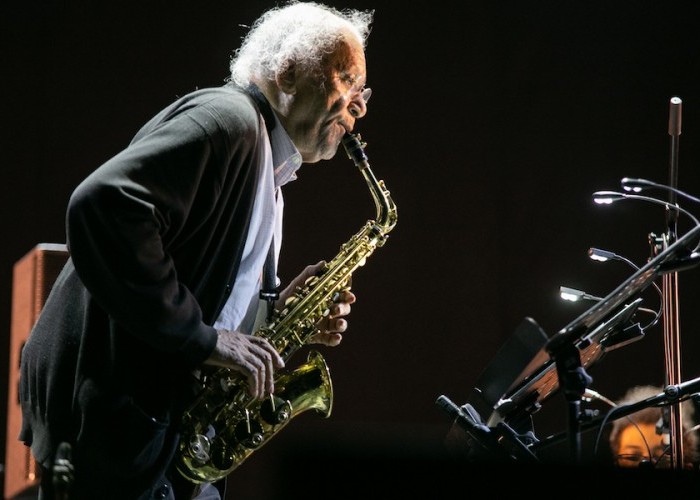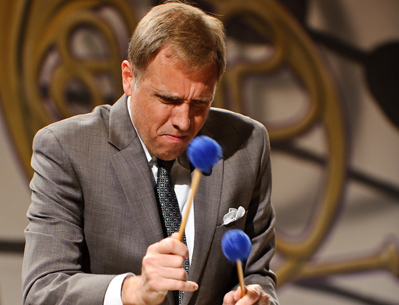Dec 9, 2025 12:28 PM
In Memoriam: Gordon Goodwin, 1954–2025
Gordon Goodwin, an award-winning saxophonist, pianist, bandleader, composer and arranger, died Dec. 8 in Los Angeles.…

Anthony Braxton led two evenings of music during Skaņu Mežs in Latvia.
(Photo: Arnis Kalnins)Anthony Braxton once told author Graham Lock that he was less interested in playing one good gig than in establishing “a body of work that becomes his own reality.” Fifty-three years after the release of his first album, the 76-year-old composer, improviser, educator, bandleader and master of many reed instruments has made good on that ambition. His 304 album-length releases explore a multitude of methodologies.
No single performance gives a complete accounting of Braxton’s means and priorities. Perhaps in recognition of this, the Skaņu Mežs festival in Riga, Latvia, recently presented Braxton’s music in two very different settings.
Skaņu Mežs has been presenting innovative music from a myriad of genres annually since 2003. It is part of SHAPE, an association of European festivals that present multidisciplinary works. This year, in a program that encompassed 20 sets over two weekends, several performers offered radical re-imaginings of electronic pop. Most notably, the Berlin-based Angolan musician Nazar evoked the terror of civil war by embedding pitch-shifted vocals and menacing samples into slick synthetic melodies and heavy bass grooves. John Wiese, an electro-acoustic composer from Cleveland, combined electrical, instrumental and concrete sounds into a cohesive, non-narrative listening experience. And San Franciscan Evicshen used turntables, an amplified bandsaw blade and her own uninhibited physical presence to invest noise with musical dynamism and a sense of danger.
Braxton debuted an “origin performance” of a prototypical approach dubbed “Lorraine,” which combines Diamond Curtain Wall Music, a computer-based environment for free improvisation, with his typically sui generis compositional approach, which requires performers to make decisions about which parts of scores they follow to navigate a piece. The players certainly turned pages at a furious rate as they played long, non-repeating figures that periodically braided into tightly knotted configurations, and then diverged to sketch out separate but complementary explorations of line and texture against the computer’s glassy, flickering backdrop. Accordionist and vocalist Adam Matlock supplied both orchestral textures and Noh theatre sonics, while brass musician Susana Santos Silva used tonal shading and melodic imagination to contribute dimensions of boldness and vulnerability. Braxton conducted the ensemble with hand gestures while playing alto, soprano and sopranino saxophones with equal fluidity, shifting from gorgeous, pure tones to coarse growls within a single phrase.
The next night, JACK Quartet’s performance of “Composition 17” (1971) revealed Braxton’s longstanding, fluent command of the language of the 20th century classical avant-garde. It fit quite naturally into a program that also included nuanced renderings of pieces by Gyorgy Ligeti, Iannis Xenakis, John Zorn and the French 14th century composer Rodericus. JACK’s treatment of Braxton’s piece emphasized its extreme dynamics and rich harmonies; heard during the same weekend as the composer’s newest music, it confirmed the persistence of his challenging vision.
The festival hosted three other artists whose music derived power, in part, from improvisational means. Alvin Curran is an 82-year-old American composer and multi-instrumentalist who has been based mainly in Rome since the 1960s. There, as a member of the group Musica Elettronica Viva, he was an early pioneer in free and electro-acoustic improvisation. As a composer, he has turned collected sounds into musical material and waterways into concert venues. At Skaņu Mežs, he alternated between a MIDI keyboard and a grand piano, using the former to orchestrate a dizzying array of voices, foghorns, roulette balls and heavy metal samples. On the latter, he threaded a path from raga-like themes to melodies he probably first played as young musician in dance bands, building to a poignant reading of “As Time Goes By.”
The collective background of GUO, the English duo of multi-instrumentalist Daniel Blumberg and saxophonist Seymour Wright, includes scoring Hollywood movies, interpreting the compositions of Coltrane associate Ahmed Abdul-Malik and free improvisation. They take their name from a Chinese word for a metal cooking vessel, and their music involves melting down sounds and ideas in a cauldron of distortion. Blumberg sang snatches of melodies that his ancestors, who migrated from the Baltic region a century ago, might have sung in Riga’s streets; Wright responded with long, frayed tones. They poured these elements into a chain of delay effects and amplifiers, transforming them into a forbidding wall of sound.
Julia Reidy is an Australian guitarist who lives in Berlin, where she frequently appears in improvisational ensembles. But her own music uses open-ended songs as platforms to explore zones of friction and concord between tuning systems. While her Auto-Tuned voice was in scrupulously precise equal temperament, her 12-string, which she re-tuned while picking, was in just intonation. The effect of her bright acoustic resonance swirling around electronically treated vocals was mesmerizing. DB

Goodwin was one of the most acclaimed, successful and influential jazz musicians of his generation.
Dec 9, 2025 12:28 PM
Gordon Goodwin, an award-winning saxophonist, pianist, bandleader, composer and arranger, died Dec. 8 in Los Angeles.…

Belá Fleck during an interview with Fredrika Whitfield on CNN.
Jan 13, 2026 2:09 PM
The fallout from the renaming of the John F. Kennedy Center for the Performing Arts to include President Donald…

Flea has returned to his first instrument — the trumpet — and assembled a dream band of jazz musicians to record a new album.
Dec 2, 2025 2:01 AM
After a nearly five-decade career as one of his generation’s defining rock bassists, Flea has returned to his first…

Dec 11, 2025 11:00 AM
DownBeat presents a complete list of the 4-, 4½- and 5-star albums from 2025 in one convenient package. It’s a great…

Vibraphonist Chuck Redd found himself in the midst of a political firestorm after canceling his gig Dec. 24 at the newly renamed Trump Kennedy Center.
Jan 6, 2026 2:32 AM
The Board of Trustees at Washington, D.C.’s Kennedy Center for the Performing Arts voted on Dec. 18 to rename the…